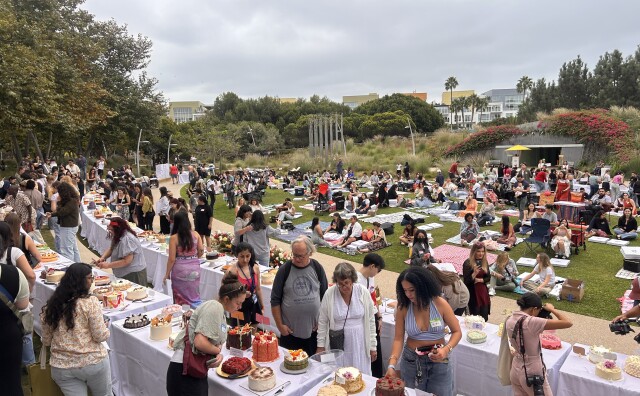Congress has cut federal funding for public media — a $3.4 million loss for LAist. We count on readers like you to protect our nonprofit newsroom. Become a monthly member and sustain local journalism.
This archival content was written, edited, and published prior to LAist's acquisition by its current owner, Southern California Public Radio ("SCPR"). Content, such as language choice and subject matter, in archival articles therefore may not align with SCPR's current editorial standards. To learn more about those standards and why we make this distinction, please click here.
Gas Leak At Risk Of Blowout, Attempts To Fix Have Only Made It Worse

Crews have already attempted to stop the leaking gas well near Porter Ranch seven times, and have only made the situation worse.State regulators say that one, of many, concern that SoCalGas has with the leaking well at their Aliso Canyon Facility is the risk of a blowout, which would leak even more gas into the atmosphere and cause a massive fire at the site. The risk of fire at the site is already so high that watches and cell phones are prohibited out of fear that an electrical spark could ignite the gas.
Things sound pretty ugly at the site, where the last attempt to stop the leak expanded a large crater that has exposed the wellhead and the control valves. According to the L.A. Times, crews began pumping slurry into the well on December 22. Unfortunately, the process only made the situation more unstable. The wellhead began to wobble and the crater grew to 80 feet long and 25 feet deep. "If the wellhead fails, the thing is just going to be full blast," Gene Nelson, a physical sciences professor at Cuesta College, told the Times. "It will be a horrible, horrible problem. The leak rates would go way up."
An attempt on November 13 caused a "geyser" to break through the surface. Prior to what officials called a "blowout to surface" in an internal memo, the gas had typically been seeping through the soil. However, during that attempt, a crew used a heavier slurry mix and the pressure from the gas caused it to gouge a hole around the well. "A large column of gas, aerated mud, and rock formed a geyser around the wellhead," the state observer wrote in a California Department of Conservation memo. "Mud brine also began to flow from around the wellhead fissures." Since that blowout, the state has required an official observer to be at the site every day.
The leak is also exposing residents to abnormally high levels of benzene, a carcinogen that is known to cause leukemia, lung cancer, and anemia. According to the Daily News, benzene levels 8-times the regional average were already detected just days after the leak was discovered, and saw a spike in November, when the leak got worse. Experts say that people should not be immediately concerned, but did find it worrisome. UC Berkeley professor Stephen Rappaport says the chance of developing cancer from the benzene from the Aliso Canyon leak was one-in-a-million, but added, "I wouldn't want it to happen to my daughter."
In the short term, almost 2,854 households have been relocated by SoCalGas from nearby Porter Ranch, with another 1,759 in the process of moving. Methane itself is harmless, but the mercaptan additive (which gives natural gas its "rotten egg" odor) is causing health problems among residents, such as headaches, nausea, and respiratory problems.
The leak was first found on October 23 and SoCalGas says it can be repaired by March at the earliest.
As Editor-in-Chief of our newsroom, I’m extremely proud of the work our top-notch journalists are doing here at LAist. We’re doing more hard-hitting watchdog journalism than ever before — powerful reporting on the economy, elections, climate and the homelessness crisis that is making a difference in your lives. At the same time, it’s never been more difficult to maintain a paywall-free, independent news source that informs, inspires, and engages everyone.
Simply put, we cannot do this essential work without your help. Federal funding for public media has been clawed back by Congress and that means LAist has lost $3.4 million in federal funding over the next two years. So we’re asking for your help. LAist has been there for you and we’re asking you to be here for us.
We rely on donations from readers like you to stay independent, which keeps our nonprofit newsroom strong and accountable to you.
No matter where you stand on the political spectrum, press freedom is at the core of keeping our nation free and fair. And as the landscape of free press changes, LAist will remain a voice you know and trust, but the amount of reader support we receive will help determine how strong of a newsroom we are going forward to cover the important news from our community.
Please take action today to support your trusted source for local news with a donation that makes sense for your budget.
Thank you for your generous support and believing in independent news.

-
Administrators say the bargaining units should be dismissed, or that they have no standing. One campus is going after the federal agency in charge of union activity.
-
The landslide is not connected to the greater Portuguese Bend landslide, city officials said.
-
Nom. Nom. Nom. The event destroyed the internet when it was first announced — and sold out in minutes.
-
The critical findings are part of long-awaited after-action report was released Thursday. It contains recommendations for increasing emergency staffing and updating old systems.
-
Diving has changed, mountain biking has been added. Here's where to watch the Olympics in person in 2028.
-
'A Great Day in the Stoke' is a free, daylong event in Orange County billed as 'the largest gathering of Black surfers in history.' The fourth annual festival is set for Saturday in Huntington Beach.







